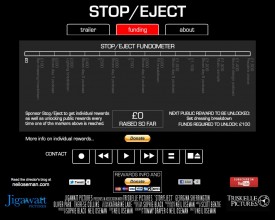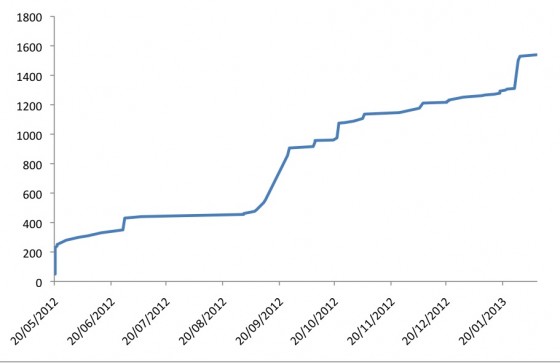
In January of last year, following the successful completion of Stop/Eject‘s preproduction crowd-funding campaign, I posted a series of four blogs evaluating the campaign. I’m now going to extend this to the postproduction campaign, once again looking at the choices we made, good and bad, and the lessons we learnt.
We knew we didn’t want to use crowdfunder.co.uk again, because it required an off-putting number of clicks for people to donate – so one of the first discussions we had was about what platform to use instead. We quickly ruled out the “all or nothing” sites. Now that the film was in the can, the important thing was to get at least some money to finish it with; the possibility of getting none at all was too risky.
My intial thought was to use Sponsume, but producer Sophie Black and my wife Katie both believed we needed to try something completely different. In the end we decided to run a campaign with no deadline, since it didn’t matter how long it took to finish the film.

We also came up with the idea of “public rewards”, so that as well as individuals receiving (for example) DVDs or premiere tickets when they donated, additional rewards would be published online for every £100 the total went up. These mostly took the form of video podcasts documenting the shoot, though a few were special blog entries breaking down the production design, lighting or budget.
As for the individual rewards, I decided to offer two options at most of the price breaks: one related to Stop/Eject, and one aimed at other filmmakers – since they had made up a significant proportion of the sponsors in the first campaign. The former type included the obvious things like DVD or Blu-ray copies of the film, invites to the premiere and glossy photo books. The latter type included a budget breakdown of my last feature film, script feedback or storyboards for your project, homemade sandbags for weighing down lighting stands, and a Skype chat with yours truly.
The public rewards and the lack of a time limit meant that no existing crowd-funding platform was suitable, so I had to knock up our own website – www.stopejectmovie.com – with a bit of simple Flash and PHP scripting and some Paypal buttons. One advantage of doing this is that only Paypal are taking a cut of the money, but a disadvantage is that a visitor to the site has less reason to trust that everything is above board.
We launched the campaign in late May of last year, with a target of £1,500. This was simply the amount we needed; it wasn’t compromised by any considerations of how much we thought we could raise.

I’m not convinced that public rewards were a good idea. When the total got stuck for a long time we were unable to use what could have been our best tool to encourage donations – releasing a podcast – because we had set up this system of releasing them only when people did donate. On the other hand, there was a knock-on effect whereby one donation would trigger the release of a public reward which would in turn trigger further donations.
I’m not sure a campaign without a deadline is something I can recommend either. In fact, I’ve since read that there’s statistical evidence showing that longer crowd-funding campaigns do not raise more money than short ones. Without the urgency of a looming deadline, many potential sponsors will say to themselves, “I’ll get around to that later,” and never do. There is also the risk that people will get fed up of being tapped for cash repeatedly over a long period.
In the next instalment I’ll look at who donated and why.